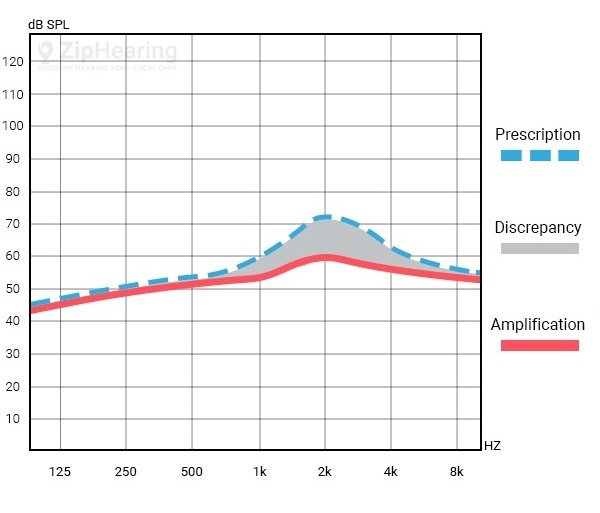Real Ear Measurement
When you’re getting your hearing aids programmed, one of the questions your hearing provider is going to undoubtedly ask you multiple times is- “now, how does that sound?”
You might respond with, “well it sounds okay, a little sharp I guess,” and your provider will make some adjustments and again ask “now, how does that sound?”
There’s nothing wrong with this exchange- it’s a normal part of the fitting process, but it’s a bit subjective, and you may at times wonder if there is a more scientific and objective approach.
Luckily, there are objective tools that a hearing care provider can use when programming your hearing aids to ensure that they’re providing the maximum benefit to you.
One of these tools, perhaps the most beneficial, is called Real Ear Measurement, or real ear verification.
What is Real Ear Measurement?
The goal of a hearing aid is to provide the correct amount of amplification for your hearing loss.
The only way to objectively verify that you’re getting the correct account of amplification is to measure it.
For example, the hearing aid manufacturer’s fitting software may dictate that 20dB of gain (amplification) should be applied at the frequency of 2kHz.
So your hearing provider powers on your hearing aids, hooks them up to the computer, and per the manufacturer’s recommendations (and based on your unique hearing loss), applies 20dB of gain at 2kHz.
The problem is, just because 20dB of gain is being provided by the hearing aid, that doesn’t necessarily mean that that is the amount of amplification that’s actually being delivered to your eardrum.
You see, each individual’s ear canal has different resonance, and this impacts the final amount of gain delivered to your eardrum.
So the final true amplification could end up being more like 23dB, or 17dB, depending on if your ear canal amplified the sound more, or dampened it.
So how do we see how much amplification is actually taking place, and whether or not the hearing aid is over, or under amplifying?
We measure it—using Real Ear Measurement, sometimes called "REM" or "real ear."
With the hearing aids in your ears and turned on, the hearing provider inserts a small microphone into your ear canal, and then plays a series of sounds.
The microphone then measures how much the hearing aid is amplifying the sounds at each frequency, and plots the results on a chart like the one shown below.
Sample Real Ear Measurement results

The blue dotted line represents how the hearing aids should be amplifying, based on your unique hearing loss and prescription.
The red solid line represents how the hearing aid are actually amplifying, as measured by the microphone.
The grey area illustrates the discrepancy between how the hearing aid should be amplifying, and how it actually is.
What this chart shows: The results show that the hearing aids are under amplifying at around 2kHz.
As a result of this under amplification, the hearing provider can now fix this, by increasing the gain that the hearing aids provide at 2kHz.
After making that fix, the provider will then run real ear measures again, this time hoping for the solid and hashed lines to be on top of each other.
If the lines are on top of each other, that indicates that the hearing aids are providing exactly the right amount of amplification at each frequency.
This is the purpose of real ear measurement- to objectively verify that the hearing aids are doing what they should be.
Is Real Ear Measurement necessary?
Consider the example above, where the hearing aid was under amplifying.
Had that error gone uncaught by real ear measurement and therefore unaddressed by the hearing care provider, the hearing aid wearer may have still been perfectly happy with the sound quality.
But, after the fix was made (and more gain applied), the wearer may have been happier.
Or, after the fix was made, they may have complained that it sounded worse than before the fix, prompting the hearing provider to undo the change.
This is the central argument around the question of “is real ear measurement necessary?”
Some providers argue that regardless of what real ear measurement results show, they are going to program the hearing aids based on the wearer’s feedback. For this reason they state that real ear measurement is not important.
Other providers will argue that real ear measurements are the foundation of the hearing aid fitting process, and regardless of the wearer’s feedback, it is the provider’s role to counsel a customer over time towards accepting the recommendations of real ear measurements.
My opinion is that both arguments have some credence, but I tend to side more with the latter argument stressing the importance of real ear measurement, as studies indicate that performing real ear measurement does improve patient satisfaction ratings.
How many hearing care providers do Real Ear Measurement?
Surveys generally indicate that about 50% of hearing care providers have real ear measurement equipment, and about a third of providers use it routinely.
This begs the question...
Why don't more hearing care providers do Real Ear Measurement?
There are typically 3 reasons hearing providers have for not performing REM:
- Perception that it’s not a useful tool: It is true that regardless of what recommendations real ear measurement makes, at the end of the day, the way the wearer perceives sound is most important, and adjustments will be made based on their feedback- not the computer’s. For example, wearers often do not want the full amount of amplification called for by their prescription. Some time is required for acclimation to amplification, and many hearing care providers will intentionally under amplify during this period, disregarding the real ear recommendations. However, the provider should still know exactly how the hearing aid performs at the eardrum, and over time hearing aids may be gradually adjusted to reach prescriptive targets as closely as possible.
- Costly equipment: This was a fair argument for a while, with the few models of real ear equipment that were available costing well over $10,000. However, there are now models that cost only a few thousand dollars. In addition, real ear measurement reduces the number of hearing aids that are returned for credit, so from a business perspective, it is a worthwhile investment.
- Lack of time: Although performing real ear measures and adjusting hearing aids to a prescription can take less than 15 minutes, providers in some of the busiest clinics may feel they do not have the time. However, a counter-argument would be that those 15 minutes can greatly reduce the need for future fine-tuning appointments.
How much does Real Ear Measurement cost?
In most cases, the fee for real ear measurement will be bundled into the purchase price of your hearing aids, if you are purchasing new hearing aids.
The fee for performing real ear measurements on existing hearing aids will usually range from free to as much as $250 per hearing aid
Do ZipHearing providers do Real Ear Measurement?
As of October ‘19, our internal surveys show that of survey respondents, about 61% of ZipHearing provider locations perform real ear measurements.
Survey of ZipHearing Providers
Through a ZipHearing provider, the median fee for real ear measurement is $75, though the majority of ZipHearing providers include real ear during the initial fitting at no additional cost.
Conclusion
In my professional opinion, more hearing care providers should be doing real ear measurements.
However, I do not think it is the “holy grail” of fitting hearing aids, nor do I think a consumer searching for a hearing provider should make the availability of real ear measurement the sole criteria in their search.
Real ear measurement is one of many tools that a hearing provider has at their disposal to achieve positive outcomes, but I believe that when choosing a hearing provider, you should look at the provider and their business more holistically.
All things being equal between two hearing care providers, I do believe a consumer would be wise to choose the provider that is able to perform real ear measurements.
However, if choosing a provider that does real ear measurements means a substantial increase in cost, I think a more “creative” solution may be warranted, which may involve paying another provider “a la carte” for real ear measurements should you deem them necessary.






